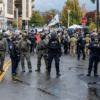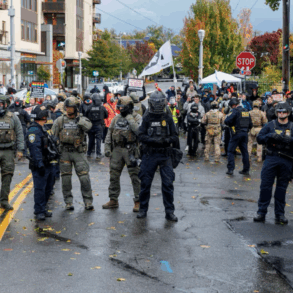On the night of June 14, 2025, Portland, Oregon, became a battleground as a violent riot erupted outside an Immigration and Customs Enforcement (ICE) facility. What began as a day of peaceful protest turned into a chaotic clash, leaving four federal officers injured and the city grappling with escalating tensions over immigration enforcement.
A Day of Protest Turns Violent
The day started with the “No Kings” protest, a massive demonstration that drew tens of thousands to downtown Portland. Labeled a “large-scale free speech gathering” by officials, the march wound through the city, ending at Waterfront Park, about five miles from the ICE facility. While the daytime event remained peaceful, the mood shifted as night fell.
By 6:30 p.m., the Portland Police Bureau (PPB) declared an unlawful assembly near the ICE building on South Macadam Avenue. A mob of rioters, armed with fireworks, smoke grenades, and rocks, began attacking federal law enforcement. According to Homeland Security Assistant Secretary Tricia McLaughlin, the group broke glass and forcibly entered the facility, creating a dangerous standoff.
Officers Under Fire
As the riot intensified, four federal officers were injured. The attackers launched explosives and hurled stones, while federal agents responded with tear gas and less-lethal weapons, including pepper balls. Images from the scene show masked protesters engulfed in clouds of green smoke, one receiving medical attention after being tear-gassed, and law enforcement standing firm in gas masks.
The PPB reported a medical emergency inside the ICE facility around 7:00 p.m., necessitating the entry of medical personnel. Police warned rioters not to interfere, threatening arrests or the use of force. By 8:00 p.m., officers observed criminal activity, including assaults and vandalism, and began making targeted arrests.
Three individuals were arrested during the riot. One was charged with assaulting a public safety officer, another for throwing a rock at the building, and a third for theft and driving under the influence after tampering with traffic control devices. In one incident, a protester allegedly pepper-sprayed officers during an arrest, though the suspect remains at large.
A Broader Wave of Unrest
The Portland riot is part of a larger surge of anti-ICE protests across the United States, fueled by recent federal immigration enforcement raids. In Los Angeles, protesters blocked freeways and set cars ablaze, prompting President Trump to deploy the National Guard and Marines. In Portland, tensions had been simmering all week, with 10 arrests on Thursday and three on Wednesday following earlier clashes at the ICE facility.
The Department of Homeland Security (DHS) also reported that ICE agents were doxxed, with posters revealing their identities, photos, and addresses plastered around the city. Despite these threats, DHS vowed to continue enforcing immigration laws. “We will NOT be deterred by rioters’ intimidation and threats,” the agency stated on X. McLaughlin echoed this resolve, saying, “Secretary [Kristi] Noem’s message to the rioters is clear: you will not stop us or slow us down.”
A City Divided
The violence in Portland highlights deep divisions over immigration policy. While daytime protests remained peaceful, the nighttime riots have drawn condemnation from officials. McLaughlin called the rioters “cowards,” noting a 413% increase in assaults on ICE officers, who she said are risking their lives to arrest “murderers, rapists, and gang members.”
Meanwhile, some protesters argue that ICE’s actions, including the recent arrests of two Newberg vineyard workers and four individuals outside a Portland Immigration Courthouse, are unjust. Advocacy groups like the Innovation Law Lab have successfully challenged some detentions, securing the release of two detainees through legal action.
What’s Next?
As Portland recovers from the June 14 riot, questions linger about how to balance free speech with public safety. The PPB’s swift response and federal agents’ efforts to secure the ICE facility prevented further escalation, but the injuries to officers and the arrests underscore the high stakes of these protests.
For now, DHS and ICE remain steadfast, promising to prosecute anyone who attacks law enforcement. As McLaughlin warned, “If you lay a hand on a law enforcement officer, you will be prosecuted to the fullest extent of the law.” With tensions still high, Portland—and the nation—brace for what may come next in this ongoing struggle over immigration enforcement.



